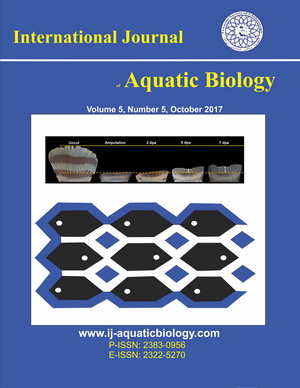16S rRNA revealed a low rate of maternal genetic variations in Cyprinus carpio Linnaeus, 1758 across the southern Caspian Sea
Downloads
Genetic diversity surveys are informative and practical tools in aquaculture and restocking programs. With its maternal inheritance, mtDNA provides direct information about the available source of genetic variations in the female brood stock. The present study investigated the maternal genetic diversity of the Caspian common carp, Cyprinus carpio, and the farmed common carp across the southern Caspian Sea using direct sequencing of 571 bp fragment of 16S rRNA. A number of eight haplotypes were identified, with an average of Hd = 0.55. A low level of population differentiation was recognized with the overall Fst = 0.01, indicating an assumption of the shared ancestry in C. carpio in the southern Caspian Sea. Among different regions, Anzali population was observed to be a more unique stock of common carp across the southern Caspian Sea basin. Hence, considering Anzali as a separate population is highly recommended to enrich the genetic diversity and avoid the population structure breakdown in C. carpio. The obtained results during the present study can be useful in the ongoing restocking activities of C. carpio along the southern Caspian Sea. Furthermore, rehabilitation of the main rivers to provide the natural breeding of anadromous fish species such as C. carpio should be considered for their future conservation.
Downloads
Balon E.K. (1995). Origin and domestication of the wild carp, Cyprinus carpio: from Roman gourmets to the swimming flowers. Aquaculture, 129: 3-48.
Bohling J., Haffray P., Berrebi P. (2016). Genetic diversity and population structure of domestic brown trout (Salmo trutta) in France. Aquaculture, 462: 1-9.
Bruford M.W., Bradley D.G., Luikart G. (2003). DNA markers reveal the complexity of livestock domestication. Nature Reviews Genetics, 4: 900-910.
Chistiakov D.A., Voronova N.V. (2009). Genetic evolution and diversity of common carp Cyprinus carpio L. Central European Journal of Biology, 4: 304-312.
Cossu P., Mura L., Scarpa F., Lai T., Sanna D., Azzena I., Fois N., Casu M. (2021). Genetic patterns in Mugil cephalus and implications for fisheries and aquaculture management. Scientific Reports, 11: 2887.
Duong,T.-Y., Uy S., Chheng P., So N., Tran T.-H.T., Nguyen N.-T.T., Pomeroy R., Egna H. (2019). Genetic diversity and structure of striped snakehead (Channa striata) in the Lower Mekong Basin: Implications for aquaculture and fisheries management. Fisheries Research, 218: 166-173.
Excoffier L., Laval G., Schneider S. (2005). Arlequin (version 3.0): an integrated software package for population genetics data analysis. Evolutionary Bioinformatics, 1: 117693430500100003.
Fallahbagheri F., Dorafshan S., Pourkazemi M., Keivany Y., Chakmedouz Q.F. (2013). An investigation on the PCR-RFLP variation of the mtDNA control region (D-Loop) in estuarine and wetland types of wild Common carp, Cyprinus carpio, in the South-West Caspian Sea. Genetic Novin, 8(2): 213-220.
Ghelichpour M., Shabani A., Shabanpour B. (2013). Microsatellite variation and genetic structure of common carp (Cyprinus carpio) populations in Gomishan Bay and Gorganroud River (Southeast of the Caspian Sea). International Journal of Aquatic Biology, 1: 22-27.
Imsiridou A., Triantafyllidis A., Baxevanis A., Triantaphyllidis C. (2009). Genetic characterization of common carp (Cyprinus carpio) populations from Greece using mitochondrial DNA sequences. Biologia, 64: 781-785.
Jafari O., Ebrahimi M., Hedayati S.A.-A., Zeinalabedini M., Poorbagher H., Nasrolahpourmoghadam M., Fernandes J.M. (2022a). Integration of morphometrics and machine learning enables accurate distinction between wild and farmed common carp. Life, 12: 957.
Jafari O., Zeinalabedini M., Robledo D., Fernandes J.M., Hedayati A.-A., Arefnezhad B. (2022b). Genotyping-by-Sequencing reveals the impact of restocking on wild common carp populations of the Southern Caspian Basin. Frontiers in Ecology and Evolution, 10: 872176.
Kohlmann K., Kersten P., Flajšhans M. (2005). Microsatellite-based genetic variability and differentiation of domesticated, wild and feral common carp (Cyprinus carpio L.) populations. Aquaculture, 247: 253-266.
Laloei F., Gilkolaei S., Taghavi M.J. (2013). Genetic diversity and differentiation of common carp (Cyprinus carpio L.) in the southern part of Caspian sea by using microsatellite markers.Asian Fisheries Science, 26(2013): 115-127
Librado P., Rozas J. (2009). DnaSP v5: a software for comprehensive analysis of DNA polymorphism data. Bioinformatics, 25: 1451-1452.
Lind C.E., Agyakwah S.K., Attipoe F.Y., Nugent C., Crooijmans R.P., Toguyeni A. (2019). Genetic diversity of Nile tilapia (Oreochromis niloticus) throughout West Africa. Scientific Reports, 9: 16767.
Mabuchi K., Senou H., Nishida M. (2008). Mitochondrial DNA analysis reveals cryptic large?scale invasion of non?native genotypes of common carp (Cyprinus carpio) in Japan. Molecular Ecology, 17: 796-809.
Moshayedi F., Eagderi S., Iri M. (2016). Body shape change in Common carp, Cyprinus carpio var. Sazan (Teleostei: Cyprinidae), during early development using geometric morphometric method. Iranian Journal of Ichthyology, 3(3): 210-217.
Napora-Rutkowski ?., Rakus K., Nowak Z., Szczygie? J., Pilarczyk A., Ostaszewska T., Irnazarow I. (2017). Genetic diversity of common carp (Cyprinus carpio L.) strains breed in Poland based on microsatellite, AFLP, and mtDNA genotype data. Aquaculture, 473: 433-442.
Palumbi S.R. (1996). The polymerase chain reaction. Molecular Systematics, 205-247.
R Core Team R. (2013). R: A language and environment for statistical computing.
Robledo D., Ogwang J., Byakora E., Nascimento-Schulze J.C., Benda K.K., Fraslin C., Salisbury S., Solimo M., Mayega J.F., Peter B. (2024). Genetic diversity and population structure of farmed and wild Nile tilapia (Oreochromis niloticus) in Uganda: The potential for aquaculture selection and breeding programs. Genomics, 116: 110781.
Ropp A.J., Reece K.S., Snyder R.A., Song J., Biesack E.E., McDowell J.R. (2023). Fine?scale population structure of the northern hard clam (Mercenaria mercenaria) revealed by genome?wide SNP markers. Evolutionary Applications, 16: 1422-1437.
Shuli Z., Weitao C., Zhi W., Yuefei L., Jie L., Xinhui L., Jiping Y. (2023). Mitochondrial diversity and genetic structure of common carp (Cyprinus carpio) in Pearl River and Nandujiang River. Journal of Fish Biology, 102: 1109-1120.
Tamura K., Peterson D., Peterson N., Stecher G., Nei M., Kumar S. (2011). MEGA5: molecular evolutionary genetics analysis using maximum likelihood, evolutionary distance, and maximum parsimony methods. Molecular Biology and Evolution, 28: 2731-2739.
Tanya C., Kumar R. (2010). Molecular markers and their applications in fisheries and aquaculture. Advances in Bioscience and Biotechnology, 2010.
Thai B., Pham T., Thai U., Austin C. (2006). Progress toward a global genealogy of common carp (Cyprinus carpio L.) strains using mitochondrial nucleotide sequences data. Naga, The WorldFish Center, 29(3/4): 55-61.
Tóth B., Ashrafzadeh M.R., Khosravi R., Bagi Z., Fehér M., Bársony P., Kovács G., Kusza S. (2022). Insights into mitochondrial DNA variation of common carp Cyprinus carpio strains in the Centre of Carpathian Basin. Aquaculture, 554: 738116.
Zenger K., Khatkar M., Cavanagh J., Hawken R., Raadsma H. (2007). Genome?wide genetic diversity of Holstein Friesian cattle reveals new insights into Australian and global population variability, including impact of selection. Animal Genetics, 38: 7-14.
Zhang R., Zhu T., Luo Q. (2023). The complete mitochondrial genome of the freshwater fish Onychostoma ovale (Cypriniformes, Cyprinidae): Genome characterization and phylogenetic analysis. Genes, 14: 1227.
Copyright (c) 2022 International Journal of Aquatic Biology

This work is licensed under a Creative Commons Attribution 4.0 International License.








